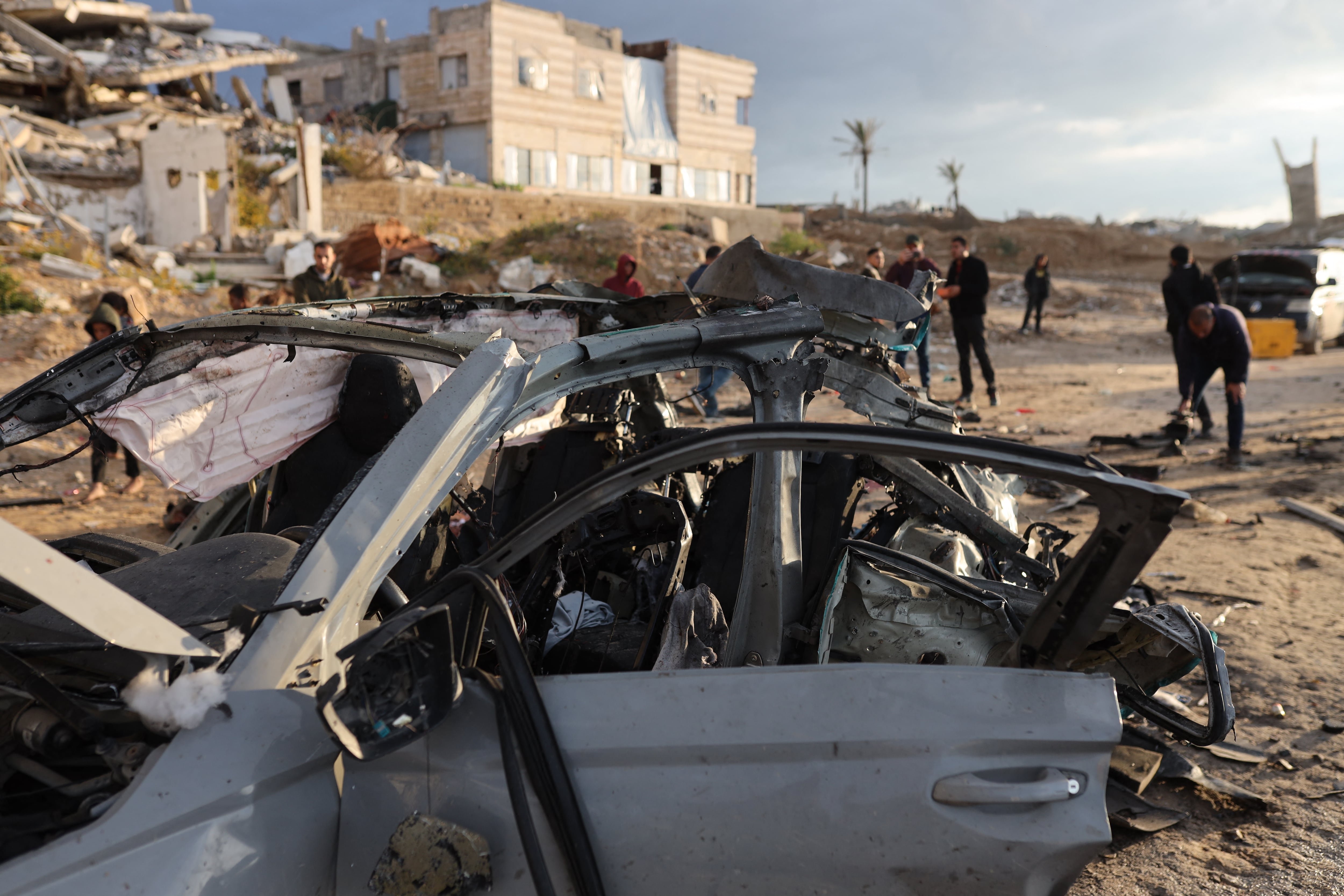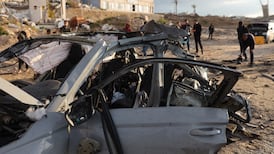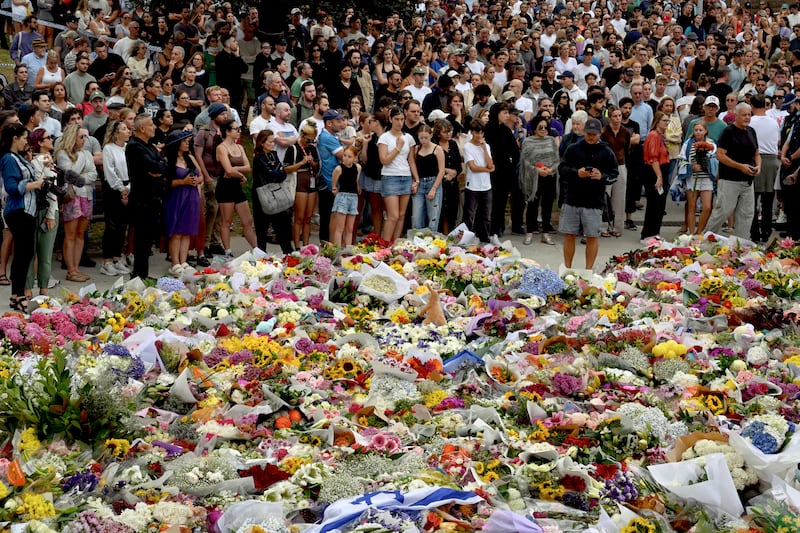Asked why he moved to Kfar Aza – a kibbutz so poor in the 1960s that when the food wagon arrived each evening, he had to choose between half a boiled egg or a slice of cheese – 67-year-old Shai Hermesh answered proudly with a single word.
“Zionism,” he said.
For the next six decades, his life traced the contours of the Zionist enterprise in Israel, both idyllic and martial. He fought as a paratrooper in the 1967 and 1973 wars, served two terms in parliament and helped build the kibbutz from an aspiring socialist utopia to a thriving, middle-class village.
On the morning of October 7th, everything he had built was destroyed by the violent adherents of an Islamist ideology dedicated to destroying Zionism. Hamas sent fighters into Kfar Aza, where some houses sit close to the border fence with the blockaded Gaza Strip. They killed at least 100 people and dragged as many hostages into the teeming enclave. Hermesh’s son was among them.
READ MORE
Across southern Israel, in an area known as the Gaza envelope, at least 1,400 Israelis were killed – both soldiers and civilians, including many women, children and elderly people, according to Israeli officials. As Israel prepares a ground offensive to root out Hamas, it has pounded Gaza from the air for more than a week, killing at least 2,750 people, according to Palestinian officials.
Tens of thousands of Israelis have fled the fighting, with the government evacuating cities as large as Sderot, with a population of 31,000. A region larger than the Gaza Strip itself is now bereft of civilians, replaced by hundreds of thousands of Israeli troops.
“The first phase was a victory for Hamas – they managed to create in southern Israel a ‘Judenrein’,” said Eitan Shamir, who helped shape Israel’s national security doctrine at the strategic affairs ministry. That is the word Nazis used to describe a region free of Jews.
Now, as Hamas prepares to battle the most powerful military in the Middle East, the militant group’s total annihilation was the only way to make Jews in Israel feel safe again, Shamir said.
“If Hamas can absorb the Israeli retaliation, then this is a major, major strategic defeat, because no Israeli will ever go back to live there,” said Shamir, now director of the BESA Center, a think tank at Bar-Ilan University.
The use of fear dates back as long as this conflict, as Jews and Arabs have fought over the land. In an infamous case, the Zionist paramilitary group Irgun massacred at least 100 Arabs in the village of Deir Yassin in 1948. Armed Arabs slaughtered Jews in the far-flung early settlements around the same time.
In 1956, Palestinian militants breached a rudimentary fence around the Gaza Strip – into which frightened refugees fled after the founding of Israel in 1948 – and butchered a security guard at the nearby kibbutz of Nahal Oz. It was one of many such cross-border raids from Gaza in the early years of the Jewish state.
[ Victims of Hamas attack appeal for international supportOpens in new window ]
At the security guard’s funeral, the famed, one-eyed Israeli general Moshe Dayan foretold the violence to come. “For years they have been sitting in the refugee camps in Gaza, and before their eyes we have been transforming the lands and the villages, where they and their fathers dwelt, into our estate,” he said.
“Beyond the furrow of the border, a sea of hatred and desire for revenge is swelling, awaiting the day when serenity will dull our path.”
Nearly 70 years later, that sea breached the high-tech fence Israel had constructed to contain the 2.3 million residents of Gaza, as militants with knives, guns and grenades burst into their neighbours’ homes and lives.
Half the survivors of Kfar Aza, 350 or so, are now suspended in a kind of purgatory, evacuated to Shefayim, another kibbutz, this time north of Tel Aviv. They have yet to bury all their dead, Hamas still holds their hostages, and their homes have become a war zone.
They have decided to stay together as a community as much as possible, transported by tragedy to a surreal reality in which children play in the lawns of a resort to which the families have been evacuated, while their parents are glued to their phones, some in a medicated haze to cling on to their humanity.
The kibbutzniks are now a rarity in right-wing Israel – secular Zionists, fired by a socialist zeal and hopeful for a two-state solution, the possibility of which has been stifled under prime minister Binyamin Netanyahu
The apparent normality was deceptive, said Nama, a medical student.
“All you see is shells,” said Nama, her eyes dark from days without sleep as she was haunted by the sound of gunshots killing her friends. “There’s nothing left inside us.”
Batia Holin (70), sat in a chair as she pondered the nature of home. Until the attack on Kfar Aza, she said, she believed that the entire frontier region close to the Palestinian enclave was heaven for 95 per cent of the time. “And 5 per cent of the time it’s hell,” she said, referring to the countless confrontations between Hamas and Israel that she has lived through.
Her family was comparatively lucky: her husband, son, daughter and grandchildren mercifully survived, while Holin fatefully skipped her usual dawn walk in the fields outside the kibbutz that Sabbath morning.
Her daughter would probably not return to Kfar Aza, she said, as she could not bring herself to walk on the same pavements where her friends were murdered. “I have no friends left,” she told her mother.
For Holin, it is more complicated. “No one will go back to the Gaza envelope if [Hamas] won’t be eliminated,” she said. “I know that’s an abstract term. What it really means is that there shouldn’t be anything that can threaten Kfar Aza and all the other communities.”
The kibbutzniks are now a rarity in right-wing Israel – secular Zionists, fired by a socialist zeal and hopeful for a two-state solution, the possibility of which has been stifled under prime minister Binyamin Netanyahu.
Their proximity with their impoverished Gazan neighbours, and the ever-present threat of infiltrations and rocket attacks, left them yearning for a lasting peace, maybe even coexistence with the Palestinians across the fence.
Holin partnered with a Gaza-based photographer once, on a shared photo exhibition, “a ray of hope in the darkness”, she said. One kibbutznik, now kidnapped by Hamas, was famous for driving the rare Gazan with a medical permit that allowed them to leave the blockaded strip across the country to the occupied West Bank for treatment.
Even now, Keren Flash (34), and her husband, Avidor Schwartzman (38), see the humanity of the Palestinians besieged in Gaza. Her parents, Cynthia and Igal, were killed in the assault, with her father’s body yet to be officially identified.
“We understand that there on the other side of the fence, they are people. They are also suffering,” she said.
Schwartzman, a former journalist-turned-media consultant, said: “The kibbutz movement is one of the main foundations and pillars of Zionist society ... Now, we don’t know what it would take to feel safe again, in this harmonious, utopian society we had created.”
The couple have lost faith in the Israeli military’s ability to protect them, as well as in the government and its intentions. Netanyahu has promised a “crushing” victory over Hamas, a task so bloody and complex that the Israeli establishment is unsure of how to accomplish it.
Complete victory will not be enough to convince Flash to return to the land. She wants something more, something neither Palestinians nor Israelis know how to achieve.
“I want complete peace,” she said. “That’s when I will return to Kfar Aza.” – Copyright The Financial Times Limited 2023



















